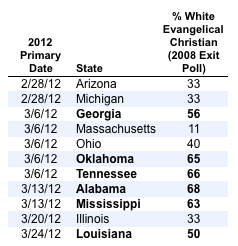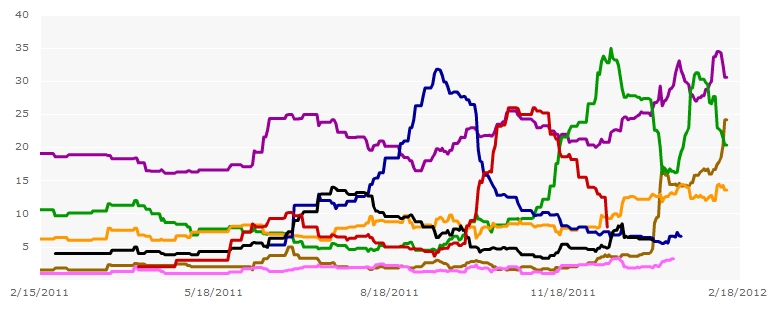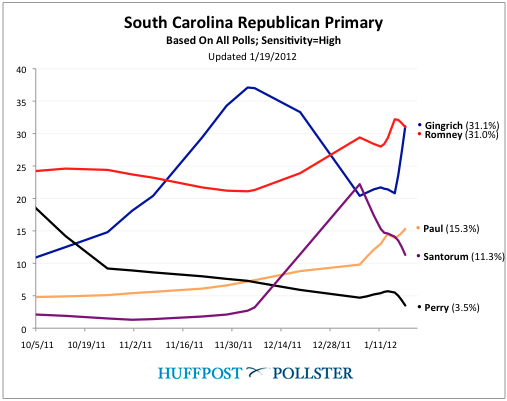In the wake of Rick Santorum’s victory in the Minnesota and Colorado caucuses, and in the Missouri beauty pageant primary, the punditocracy has gradually begun to accept an argument you’ve heard me make since August: Mitt Romney is a weak frontrunner who has never demonstrated the capacity to win over the non-Mormon Tea Party-sympathizing conservative faction of the Republican Party. Sarah Palin, in her speech to CPAC yesterday, captured that sentiment quite well I thought.
The danger, however, is that pundits will now overreact by endowing Santorum with electoral strength that to date he has not demonstrated. Keep in mind that Santorum has not won a single state in which participation rates among eligible voters climbed into double digits. Indeed, as the following table shows, two of his three caucus victories came in events with participation rates under 2% (figures based on Michael McDonald’s election turnout website). Turnout in Missouri’s largely meaningless primary, meanwhile, was the lowest of any primary state so far (and keep in mind that Gingrich’s name was not on the ballot there.) In Iowa, the caucus state with the highest turnout, Santorum essentially spent half a year campaigning there.
| STATE | TYPE | VOTES CAST | %Eligible Population | WINNER |
| Iowa | Caucus | 122,255 | 6.5% | Santorum |
| New Hampshire | Primary | 249,655 | 31.1% | Romney |
| South Carolina | Primary | 603,770 | 17.6% | Gingrich |
| Florida | Primary | 1,672,352 | 12.8% | Romney |
| Nevada | Caucus | 32,894 | 1.9% | Romney |
| Minnesota* | Caucus | 47,696 | 1.2% | Santorum |
| Colorado | Caucus | 65,535 | 1.8% | Santorum |
| Missouri | Beauty Pageant Primary | 251,868 | 7.4% | Santorum |
| Maine* | Caucus | 5,524* | .5% | Romney |
*Denotes Estimates Based on Incomplete Results
It is true that Santorum is surging in the national polls. Indeed, the latest PublicPolicyPolling national poll has Santorum trouncing the Republican field with 38% of the vote to Romney’s 23%, Gingrich’s 17% and 13% for Ron Paul. Other polls indicate he has moved ahead of Gingrich nationally into second place. The RealClearPolitic’s composite polling tracker now shows Santorum’s average climbing to 24%, only 6% behind the leader Romney (Mitt=purple, Gingrich=green, Santorum=brown):
But we shouldn’t overreact to these national polls. Rather than demonstrating deep-rooted support for Santorum, they are more likely reflecting voters’ current read of the race, as indicated by the prevailing media narrative. That is, respondents are answering the poll in terms of who they think is doing well according to the media coverage – not who they will necessarily support in upcoming events.
And it is those upcoming events that will test just how strong and widespread Santorum’s support is. After primaries in Michigan and Arizona on February 28, Republicans hold seven primaries on “Super Tuesday”, March 6. Of those, three – Georgia, Tennessee and Oklahoma can be considered southern or southern-leaning states with large delegate hauls. (Neither Santorum nor Gingrich qualified to be on the ballot in a fourth Super Tuesday state – Virginia.) Why does this matter? Because as Mark Halperin notes, those “southern” states contain a high proportion of evangelicals, and – so far, at least – those southern evangelicals have been supporting Gingrich. Here’s data compiled by Halperin showing the percent of white evangelical Christians vote, based on 2008 exit polls, in those states that will hold primaries in the next month. Gingrich can be expected to more than hold his own in most of those states.

Two other Super Tuesday states – Massachusetts and Vermont – promise to go heavily for Romney. This doesn’t leave much room for Santorum to break out of the pack. Indeed, if voting trends hold among southern evangelicals, Gingrich, and not Santorum, is likely to come out of Super Tuesday with greater momentum as the Mitt-alternative. This despite the fact that the media has – again – largely written Newt out of this race.
This scenario makes it imperative for Santorum to do well in Michigan and, on Super Tuesday, to at least run competitively in Ohio – two rust-belt states in which Santorum’s more populist conservative message may resonate. (Keep in mind that Romney runs weaker among social conservatives, not necessarily economic conservatives – at least not the higher income ones.) Gingrich, however, has already been barnstorming Ohio in the hope to win some delegates there. Unless Santorum’s support begins to broaden as a result of last Tuesday’s victories, I still don’t think he’s well positioned to win the nomination.
This is all a long way of reiterating a point I made after Tuesday’s results: Mitt Romney remains a very weak frontrunner – one who can be beat, but only if conservative Tea Party-supporting Republicans settle on an alternative. At this point, it’s not obvious to me that Santorum is that person. To convince me otherwise, he needs to win a big-state primary. He’s got two weeks to make that happen.



